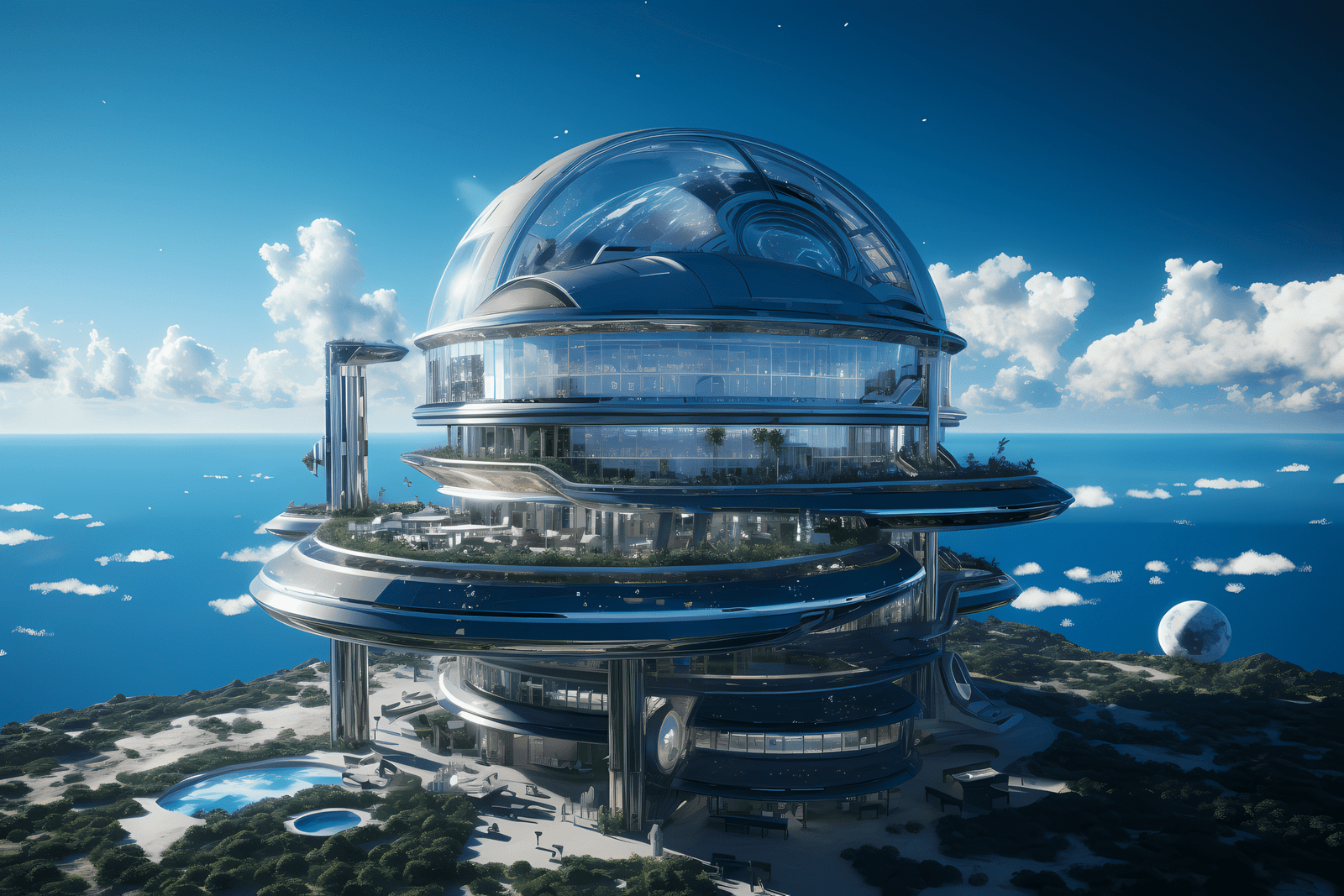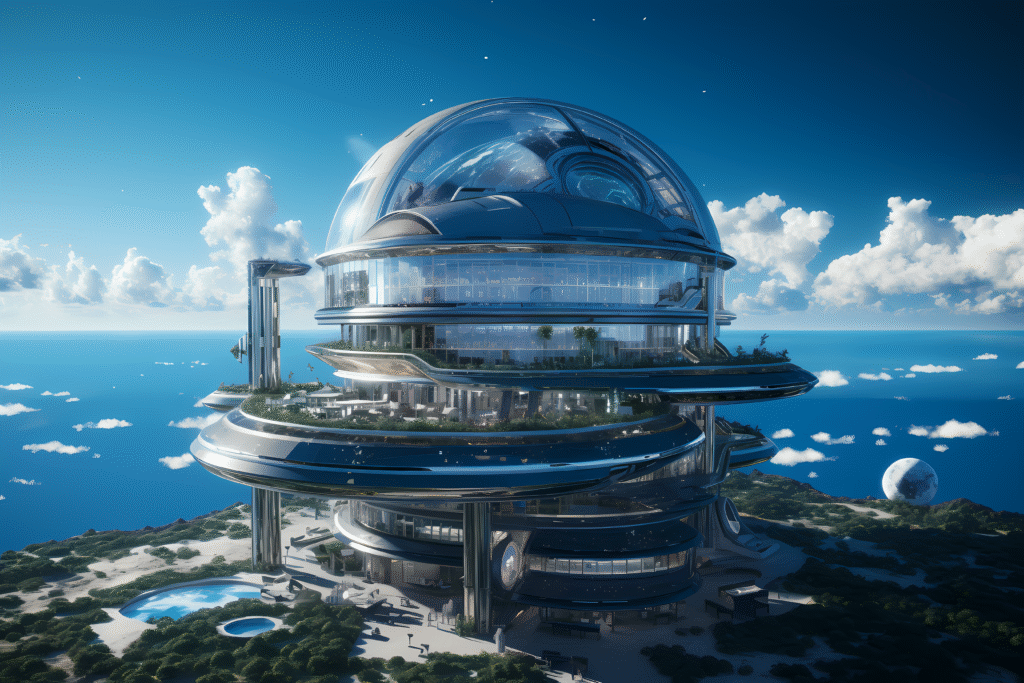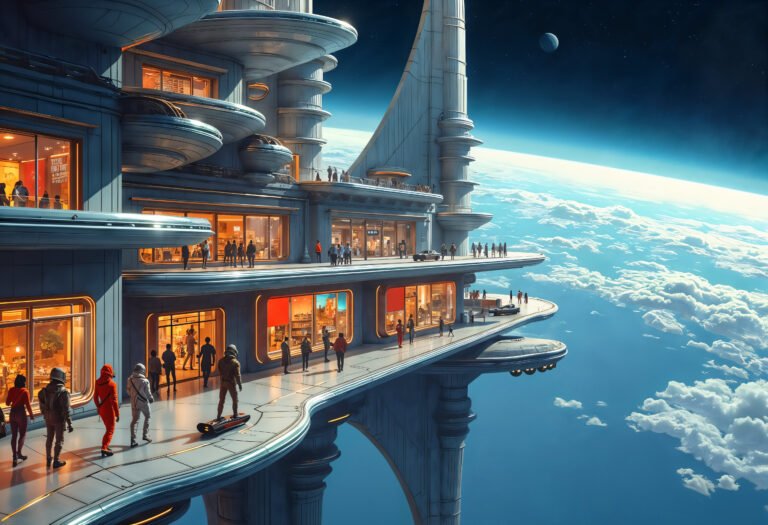Top 12 Futuristic Hotels Planned for Space in the Next 20 Years

Futuristic Hotels: Imagine checking in to a hotel that orbits the Earth, spins to make artificial gravity, and serves cocktails with an infinite view of the planet below. The space-hotel future is closer than you think — private companies, national space agencies, and hospitality brands are designing orbital resorts, lunar stopovers and near-space experiences meant to bring tourism out of the realm of speculative fiction and into travel brochures over the next two decades (2025–2045). Below is a deeply researched, SEO-first, human-written guide to the Top 12 space hotels planned, with practical details, timelines, what to expect, tips & tricks, a compact info table, FAQs and a conclusion.

Table of Contents
1) Voyager Station — Orbital Assembly (luxury rotating hotel)
What it is: A wheel-style rotating hotel designed to generate artificial gravity in part of its ring, with suites, restaurants, a cinema, gym and entertainment spaces. Capacity figures have been reported between ~280 and (in some updated releases) up to ~400 guests in larger designs. www.ndtv.com+1
Timeline & status: Orbital Assembly (Above: Space Development) has published aggressive timelines (public renderings often cited 2027/late 2020s) but independent reporting treats the date as optimistic — still, the company continues to promote Voyager and a smaller Pioneer concept. Treat early launch dates as aspirational until hardware and firm contracts are publicly verifiable. Orbital Today+1
What the guest experience might be: luxury suites (some with partial artificial gravity), zero-g play zones, large panoramic windows, spa & wellness, fine dining, concerts and themed activities. Expect robust training, medical clearance and a ticket price targeted initially at ultra-high-net-worth customers. Architectural Digest
Why to watch: If realized, Voyager sets the template for a resort-style orbital destination — scale, gravity comfort, and hospitality integrations shape the rest of the industry.
2) Pioneer Station — Orbital Assembly (boutique rotating stay)
What it is: A smaller sister concept to Voyager — a rotating “boutique” with fewer guests (OAC has described numbers in the dozens). Faster, cheaper to build in concept and pitched as a near-term first product. Smithsonian Magazine
Timeline & status: Announced as able to open earlier than Voyager (press materials in 2021–2024 referenced 2025 as an early target); again, treat dates cautiously and follow construction milestones. Blooloop
Guest profile: short stays for affluent tourists or groups, photographic vantage points, artificially generated partial gravity in the ring.
3) Starlab — Voyager Space + Airbus + Hilton (hospitality + research)
What it is: A commercial space station being developed via a joint venture (Voyager/Airbus/Mitsubishi/MDA) with hospitality design partnership with Hilton — pitched for both research and hospitality suites, blending hotel standards with microgravity research. NASA and other national agencies have supported aspects of commercial LEO station development. Voyager+2Voyager+2
Timeline & status: Starlab has progressed through development and received funding/award signals; Voyager Space and partners have signaled launch windows in the later 2020s (2028 often cited for earlier operational ambitions). Starlab aims to be a major commercial LEO destination after ISS retirement. Starlab – A New-Era Space Destination
Why it matters: A recognized hotel brand (Hilton) partnering on design raises confidence that hospitality standards will be front-and-center, with an emphasis on guest experience and ground-to-space customer journeys.
4) Axiom Station — Axiom Space (modular commercial station)
What it is: Axiom is building modules to attach to the ISS and later operate as a free-flying commercial station (Axiom Station) with dedicated modules and premium habs that will host researchers, paying guests and corporate occupants. Axiom also runs private missions to the ISS and is among the most operationally mature commercial providers. Axiom Space+1
Timeline & status: Axiom’s ISS-attached modules are under assembly and testing; the company has sold private astronaut missions and plans to evolve into independent station operations through the late 2020s. Axiom Space
Guest experience: Philippe Starck–style interior concepts have been mentioned; expect short orbital stays integrated with training programs and higher degrees of access to research facilities (price estimates historically indicated multi-million-dollar stays). Space
5) Orbital Reef — Blue Origin + Sierra Space (a mixed-use “space park”)
What it is: Orbital Reef is positioned as a “mixed-use business park” in LEO — commercial labs, manufacturing, and tourism cabins. The design is modular (LIFE module, core modules) and intended to host a mix of customers from researchers to tourists. sierraspace.com+1
Timeline & status: Initially pitched for late-2020s partial operations (some documentation cited 2027), public milestones and NASA-supported testing for life-support systems have been reported; more conservative commentary suggests broader availability by ~2030. NASA+1
Why it might host tourists: Blue Origin + Sierra Space bring launch and habitat tech (plus Dream Chaser and New Glenn plans), and Orbital Reef’s modular approach aims to open slots for hospitality or cabin modules.
6) Haven-1 & Haven-2 — Vast (the first small commercial stations)
What they are: Vast’s Haven-1 is a compact commercial station intended as an early, bookable destination for crews and possibly guests; Haven-2 is a follow-on, larger design. Haven-1 is explicitly pitched as a commercial station with private missions planned. vastspace.com+1
Timeline & status: As of mid-2025 Vast reported hardware progress and targeted a 2026 launch for Haven-1 (industry reporting in 2025 discussed completed primary structure work and testing). Spaceflight Now+1
Guest experience: Smaller, science-first with limited “hotel” capacity — but a realistic near-term commercial option for a month-long (or shorter) paid stay. Expect tight quarters, domed viewing windows and science-oriented itineraries.
7) Lunar Gateway — NASA + international partners (cislunar stopover — future hospitality)
What it is: The Lunar Gateway is a planned international station in near-rectilinear halo orbit around the Moon (NRHO). While designed for Artemis missions, it becomes an obvious cislunar hub where hospitality modules, commercial payloads and possibly tourism stopovers could be integrated in the 2030s. NASA+1
Timeline & status: PPE + HALO modules have scheduled launches (e.g., Falon Heavy launches targeted in the late 2020s), and Gateway assembly is planned across Artemis missions — near-term dates are subject to program funding and international decisions. NASA
Why include it: Although not a hotel in its baseline design, Gateway will create cislunar infrastructure and demand for hospitality-style services (luxury lunar transit accommodations, short lunar orbital stays) as lunar surface activity grows.
8) Moon World / MOON (Dubai and conceptual lunar resorts)
What it is: Moon World Resorts (and similar proposals) propose Earth-based and lunar surface resort concepts (e.g., the MOON Dubai structure and commercial lunar resort proposals). Some projects are purely architectural/branding concepts intended to capitalize on space tourism interest. Architectural Digest+1
Reality check: These are concept/PR-heavy projects — exciting design work but often far from hardware contracts and lacking verified lunar logistics. Consider them aspirational — potentially relevant if Earth-to-Moon transit costs fall and surface habitats become economical.
9) Bigelow-style inflatable habitats (B330 / inflatable modules)
What it is: Inflatable habitats (like Bigelow’s B330 and earlier BEAM test module) maximize habitable volume per launch mass and are a natural fit for hotel modules: more room per kilogram, softer interiors and lower launch-fairing constraints. NASA tested BEAM aboard ISS; Bigelow’s B330 remains a core concept for future private habitats. Wikipedia+1
Timeline & status: Bigelow Aerospace paused operations in 2020, but the tech (and partner interest) survives in concept and academic work. Inflatable modules are likely to reappear under other developers or partnerships. Wikipedia
Why it matters: Inflatable modules could be the economical way to build “hotel wings” on station ecosystems.
10) SpaceX Starship station conversion concepts (speculative)
What it is: NASA and industry commentators have floated the idea of converting Starship or using Starship-class hardware as very large orbital habitats. This is a speculative pathway rather than a currently announced hotel product — but Starship’s lift and volume make it a natural enabler for future large hotels, depots or hubs. Space+1
Reality check: SpaceX has not announced a Starship hotel product; the conversion idea is being studied and appears mainly in concept/analysis pieces. Treat as high-potential, high-uncertainty.
11) Orion Span’s Aurora (lessons from an early space-hotel startup)
What happened: Orion Span’s Aurora Station (announced earlier as a luxury hotel) failed to deliver on its original launch timeline; the company and timeline issues illustrate the high risk for early space-hotel startups. The Aurora story is a cautionary tale: early PR and pre-orders do not equal certified hardware or safe, bookable trips. SiteMinder
Why include it: Understanding failures helps prospective bookers and investors separate credible projects from marketing hype.
12) Near-space hotels & experience operators (balloon capsules, stratospheric pods)
What they are: Companies like Space Perspective (stratospheric balloon capsules) offer multi-hour to multi-day near-space experiences that function like “very high-altitude hotels” — not orbital hotels, but much more accessible and likely to scale sooner. These are part of the broader “space hospitality” bucket and offer a cheaper, more accessible alternative to orbit. Revfine.com
Why this matters: For many travelers the “space hotel” dream becomes realistic first via near-space pods and orbital short stays; these are lower cost, lower training, and earlier to market.
Compact info table — the Top 12 at a glance
| # | Project / Concept | Lead(s) | Target / Role | Rough timeline (reported) | Current status (2025-2026 snapshot) |
|---|---|---|---|---|---|
| 1 | Voyager Station | Orbital Assembly / Above | Large rotating hotel (artificial gravity) | Renderings claim ~2027 (aspirational). | Active PR, renderings, planning. Orbital Today |
| 2 | Pioneer Station | Orbital Assembly | Small rotating boutique hotel | Claimed near-term (mid-2020s in press). | Concept / early product pitch. Smithsonian Magazine |
| 3 | Starlab | Voyager/Airbus/Mitsubishi + Hilton | Research + hospitality commercial station | Mid/late 2020s (2028 often cited). | JV development; hospitality partner Hilton. Starlab – A New-Era Space Destination |
| 4 | Axiom Station | Axiom Space | Commercial station & suites | Late 2020s (modules under build). | Modules progressed; private missions sold. Axiom Space |
| 5 | Orbital Reef | Blue Origin + Sierra Space | Mixed-use space park (tourism + research) | Partial ops late-2020s; fuller ops ~2030. | Development & NASA milestone testing. NASA |
| 6 | Haven-1 / Haven-2 | Vast | Small commercial stations | Haven-1 targeted 2026 (company reporting). | Hardware progress reported; test milestones. Spaceflight Now |
| 7 | Lunar Gateway | NASA + ESA/JAXA/CSA | Lunar orbital hub (science & staging) | PPE+HALO ~2027; I-HAB ~2028+. | Govt program; hardware contracts active. NASA |
| 8 | MOON / Moon World | Moon World Resorts (private) | Lunar resort concepts / Earth replicas | Conceptual (no firm lunar launches). | Architectural / PR concept. Architectural Digest |
| 9 | Bigelow-style B330 | Bigelow / inflatable tech | Inflatable modules for hotels | Historic plans (B330 concept), tech proven (BEAM). | Inflation tech proven; Bigelow pause. Wikipedia |
| 10 | Starship station ideas | SpaceX (concepts explored) | Speculative Starship-derived habitats | Studied conceptually; no firm product timeline. | Concept & feasibility discussion. Space |
| 11 | Aurora Station (Orion Span) | Orion Span (startup) | Early luxury hotel idea — stalled | Announced (past dates missed). | Example of early startup risk. SiteMinder |
| 12 | Near-space pods | Space Perspective, others | High-altitude balloon/stratospheric stays | Already offering reservations; early 2020s. | Operational / earliest mass market option. Revfine.com |
Practical tips & tricks if you want to go (booking & readiness)
- Start training early — most orbital providers will require medical checks and basic microgravity orientation (some offer pre-flight simulators). Expect multi-week training for orbital stays. GeekWire
- Budget realistically — early orbital hotel stays will cost millions for multi-day stays; near-space pods and stratospheric experiences are far cheaper (tens to hundreds of thousands). Space
- Check refund & insurance terms — spaceflight cancellations, scrubbed launches and schedule slips are common; buy travel insurance tailored to space tourism where available.
- Health considerations — microgravity impacts (space motion sickness, fluid shifts) and radiation exposure are real. Consult a space-medicine specialist for any preexisting conditions.
- Expect evolving experiences — the first guests will be test-bed travelers; features will improve as stations mature. Consider being an early adopter only if you accept some experimental risk.
- Follow credible signals — hardware milestones (completed welds, successful life-support tests, signed launch contracts) are stronger signals than glossy renderings. Spaceflight Now+1
FAQs — (5–7 common questions answered)
Q1: When will the first real space hotel open?
A: There is no single authoritative date. Several companies pitched near-term openings (Pioneer claims, Voyager claims for the late-2020s), and more conservative industry reporting suggests the first commercial, bookable orbital stays are likeliest in the latter half of the 2020s to early 2030s — with near-space pods already selling reservations today. Always check official launch/mission milestones. Smithsonian Magazine+1
Q2: How much will a space-hotel stay cost?
A: Early orbital stays are expected to be in the multi-million dollar range for multi-day packages (historical price quotes for private ISS missions were tens of millions), while near-space balloon stays target much lower price points. Expect a premium for the first decade. GeekWire
Q3: Do hotels in orbit use artificial gravity?
A: Some hotel concepts (Voyager/Pioneer) propose rotating sections to simulate partial gravity; many other designs (Axiom, Orbital Reef, Haven-1) will operate in microgravity. Artificial-gravity rings are engineering-intensive and represent mid-to-long-term design choices. Architectural Digest
Q4: Will I need astronaut training?
A: Yes — even short orbital stays will require medical screening and training (safety protocols, emergency drills, basic operations). Near-space flights require less preparation. GeekWire
Q5: Are these hotels safe?
A: Safety is improving as commercial providers iterate with agency partnerships; however, space remains inherently riskier than terrestrial travel. Look for programs with established flight hardware, regulatory approvals and transparent safety records. NASA
Q6: Can ordinary travelers (non-rich) expect to stay in space by 2045?
A: Costs will likely fall over time, especially if heavy-lift/low-cost access (e.g., Starship) and commoditized hospitality modules scale. By 2045 broader access is plausible, but price parity with luxury travel on Earth is unlikely for many decades.
Final thoughts & conclusion
Space hotels are not a single technology problem — they require advances in launch economics, certified life-support, operational logistics, hospitality design adapted to microgravity (or artificial gravity), and robust partnerships between aerospace firms and hospitality brands. The projects above represent a mix of near-term commercial realism (Vast, Axiom, near-space providers), credible engineering megaprojects (Orbital Reef, Starlab) and visionary, high-risk concepts (Voyager Station, Moon resorts). If you’re a traveler, investor, or travel-writer, focus on firms that demonstrate hardware milestones (welds, flight contracts, life-support tests) and established launch/service partnerships. If you want to chase the first-in-line experience: track Vast, Axiom and near-space providers for the earliest realistic options; watch Voyager/Starlab/Orbital Reef for large-scale hospitality rollouts later in the 2020s/2030s. Spaceflight Now+2Axiom Space+2






